Order 330 of the Ministry of Health of the Russian Federation "On measures to improve clinical nutrition in medical institutions Russian Federation"On measures to improve therapeutic nutrition in medical institutions of the Russian Federation" and Order 395 n from g "On approval of the norms of therapeutic nutrition" 6 groups of standard diets: General variant of the diet (ATD) General variant of the diet (ATD) With mechanical and chemical Protein sparing (SHD) Mechanically and chemically sparing (SHD) High protein diet (EPD) High protein diet (EPD) Low protein diet (LPD) Reduced protein diet (LPD) Low calorie diet (LPD) Low calorie high calorie diet (HQD) high calorie diet (HQD)

Normative documents of the joint venture "Sanitary and epidemiological requirements for public catering organizations, the manufacture and defense capability of food products and food raw materials in them"; JV “Sanitary and epidemiological requirements for public catering organizations, production and defense capability of food products and food raw materials in them”; San PiN from "Sanitary and epidemiological requirements for organizations engaged in medical activities." San PiN from "Sanitary and epidemiological requirements for organizations engaged in medical activities." San PiN "Hygienic requirements for the expiration date and storage conditions of food products"; San PiN "Hygienic requirements for the expiration date and storage conditions of food products"; JV "Organization and implementation of production control over compliance with sanitary rules and the implementation of sanitary and anti-epidemic (preventive) measures." JV "Organization and implementation of production control over compliance with sanitary rules and the implementation of sanitary and anti-epidemic (preventive) measures." GOSTs, Technical conditions and Technical regulations for products entering the warehouse for the preparation of medical nutrition
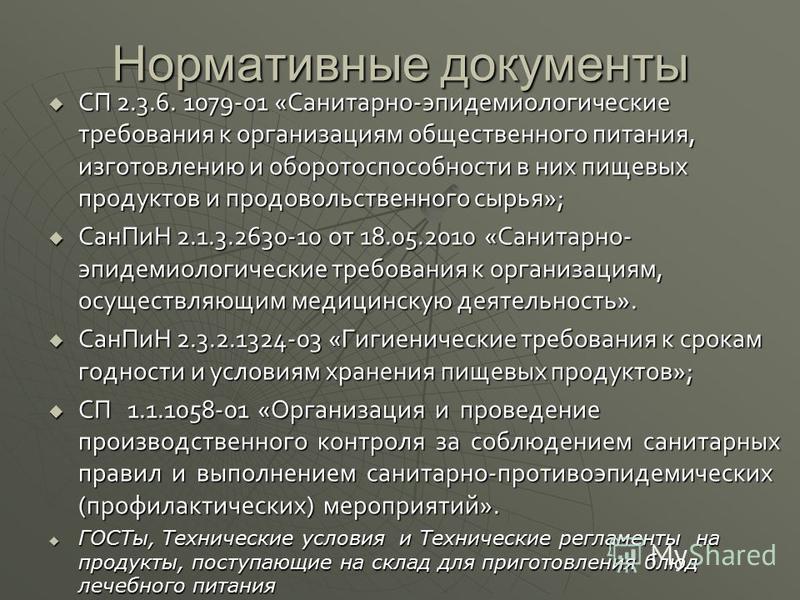
Stages of the organization of clinical nutrition: Formation of an application for products Formation of an application for products Organization of purchases of products and nutritional mixtures Organization of purchases of products and nutritional mixtures Organization of the work of the food unit Organization of the work of the food unit Cooking process diet meals The process of preparing dietary dishes Prescribing medical nutrition Prescribing medical nutrition Correction of therapeutic diets Correction of therapeutic rations Fulfillment of standards in accordance with the regulatory requirements of therapeutic rations Fulfillment of standards in accordance with the regulatory requirements of therapeutic rations Stages of organization of therapeutic nutrition: Formation of an application for products Formation of an application for products and nutritional mixtures Organizing the purchase of products and nutritional mixtures Organizing the work of the catering unit Organization of the work of the catering unit The process of preparing dietary meals The process of preparing dietary meals Prescribing medical nutrition Prescribing medical nutrition Correction of therapeutic diets Correction of therapeutic rations Fulfillment of standards in accordance with the regulatory requirements of therapeutic diets Fulfillment of standards in accordance with regulatory requirements of therapeutic diets Organization Coordination Control
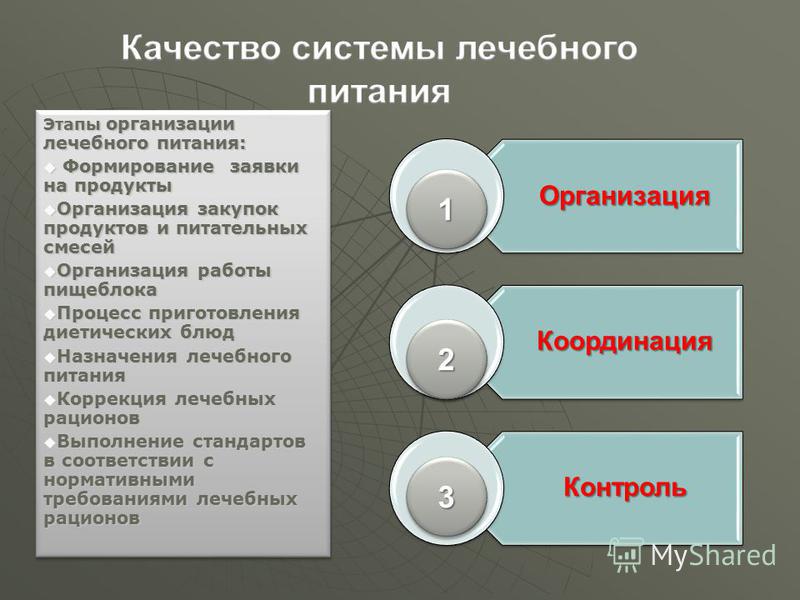
Head physician of the hospital General management of nutrition of patients Head of department, Management of nutrition of patients in the department Nutritionist (dietary nurse) Organization of medical nutrition Chef, cook Cooking at the catering department Barmaid Receiving food, portioning, distribution in the department Chief nurse Organization of medical nutrition in departments

Coordination of work on therapeutic nutrition The therapeutic nutrition council The composition of the therapeutic nutrition council is approved by the order of the chief physician of the medical institution The therapeutic nutrition council is convened by the chief physician at least 1 time in 3 months

Quality control of products and prepared food Quality control of products and prepared food Checking the quality of prepared food before delivery from the catering unit to departments Checking the quality and yield (by weighing) of semi-finished products after primary processing Checking upon receipt of the daily supply and compliance with the technological process Checking the good quality of products when they are arrival at the warehouse
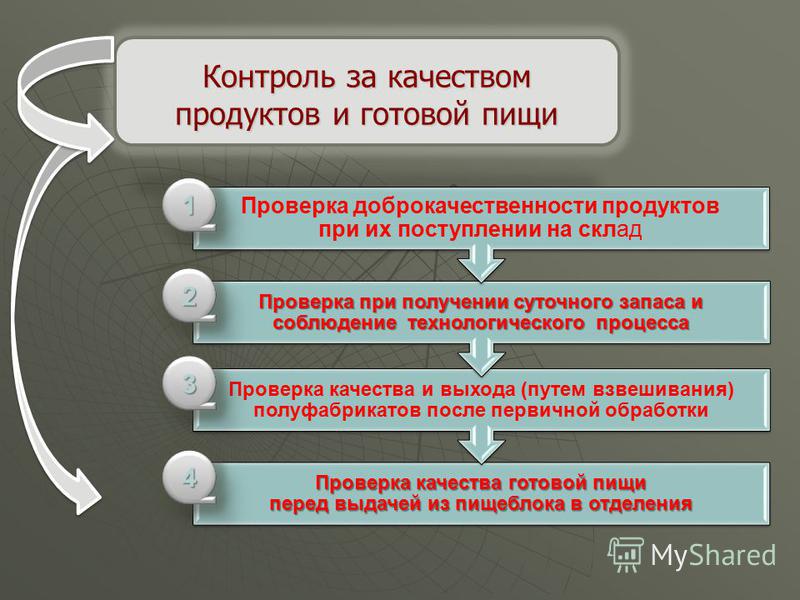
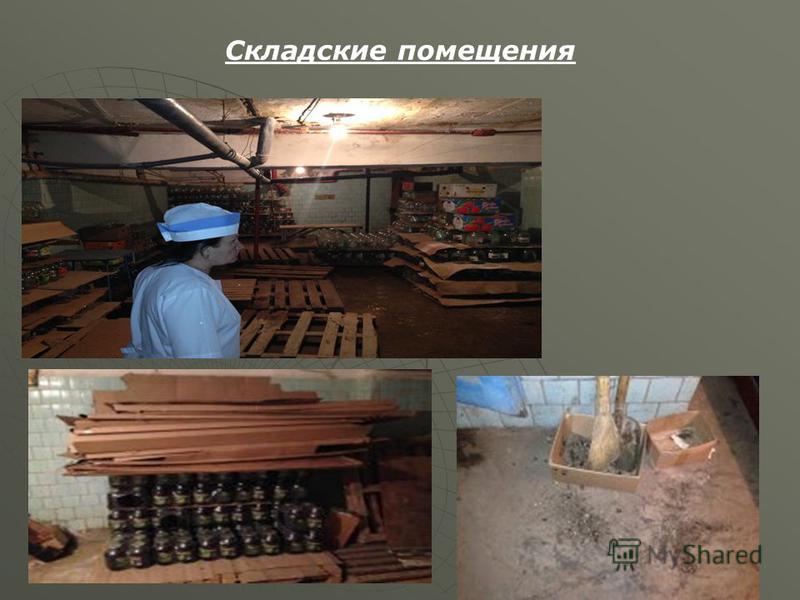
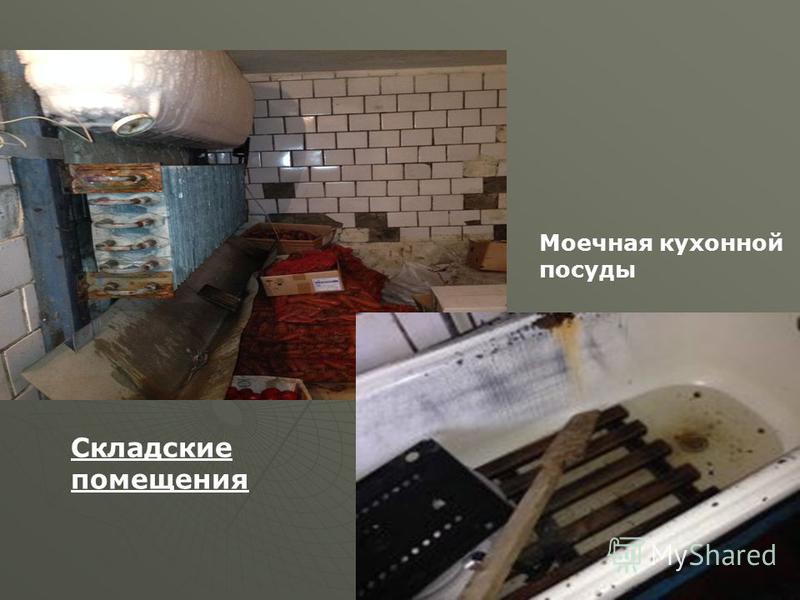
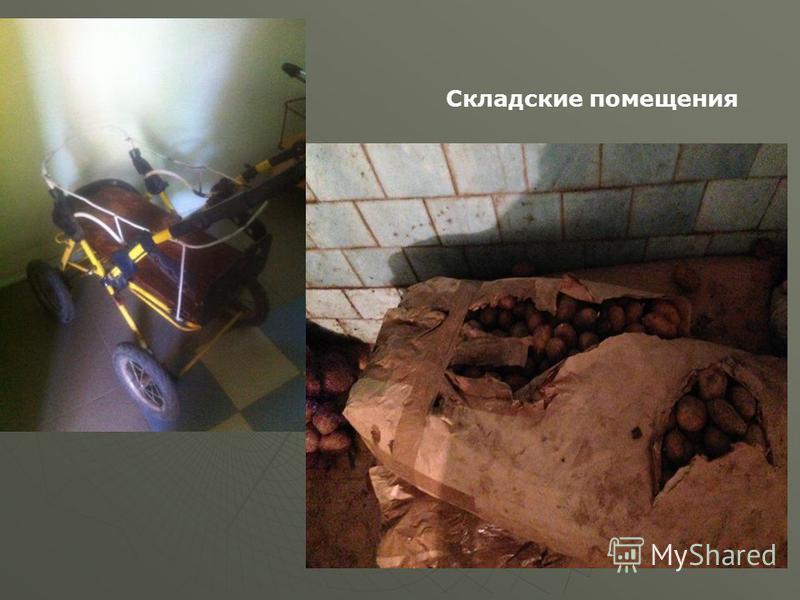
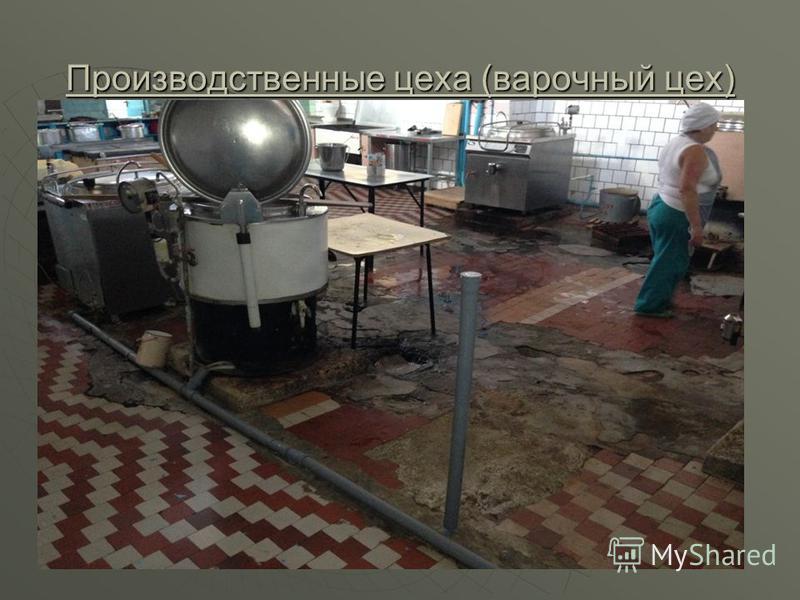
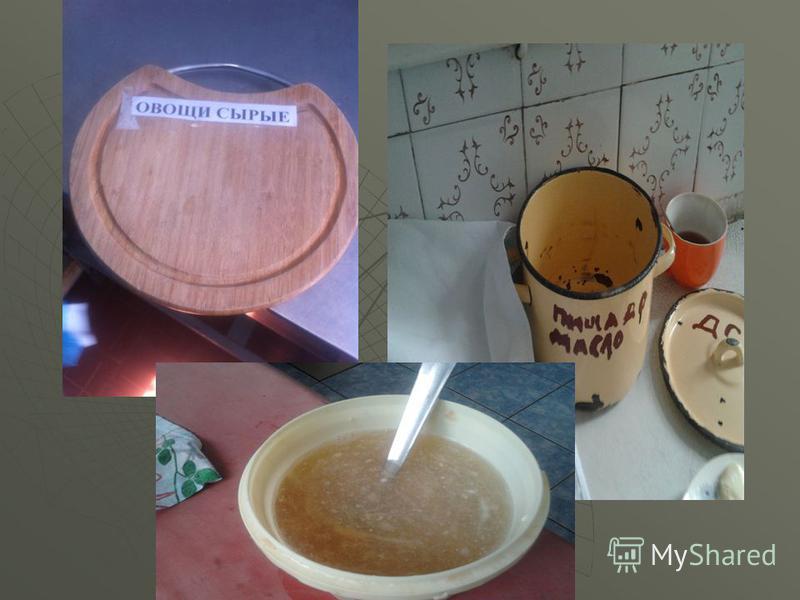

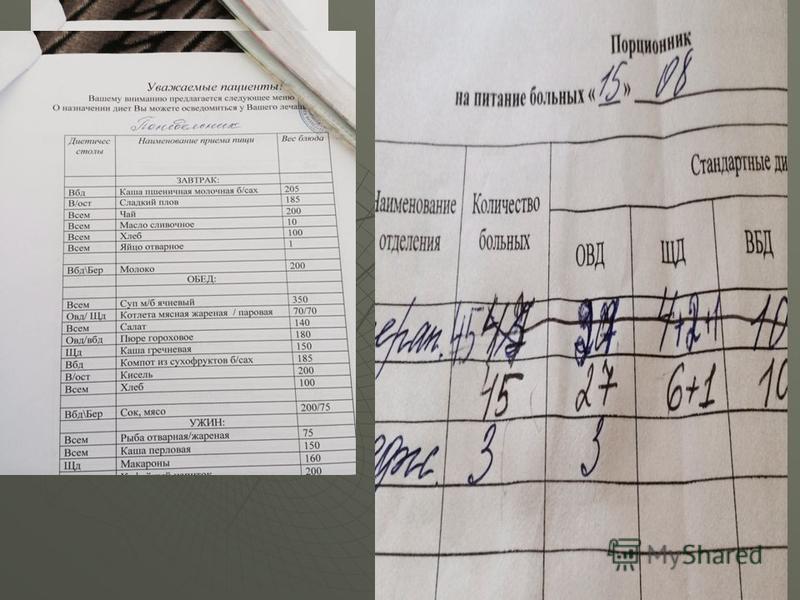
The procedure for prescribing and dispensing food for patients (according to Pr 330 of the Ministry of Health of the Russian Federation “On measures to improve clinical nutrition in healthcare facilities of the Russian Federation” and Pr 530 “Accounting for food in healthcare facilities”. In the morning, nurses prepare information for the st. m / s on the number of patients and their distribution according to diets (should be written in the appointment sheets) St. m / s is "Portion for the nutrition of patients" Form 1-84-MZ in one copy. The document must be signed by the head of m / s and the head of the department In the morning, the nurses prepare for the senior m/s information on the number of patients and their distribution by diet (should be written in the appointment sheets). copy.The document must be signed by the nurse and the head of the department.Additional or individual meals are issued in two copies, signed by the attending physician, head of the department and approved by the head physician.One copy is transferred to the dietary service, the second remains in the history of more know. Additional or individual meals are issued in duplicate, signed by the attending physician, head of the department and approved by the chief physician. One copy is transferred to the dietary service, the second remains in the medical history. All information must be transferred to the catering unit before 9 am, in order to compile, using these forms, “Summary information on the presence of patients on food” for the whole health facility. This document is verified with the data of the admission department and statistics data, certified by the signature of the chief physician. This is done to ensure that there is no discrepancy between the data on the actual number of patients. All information must be transferred to the catering unit before 9 am, in order to compile, using these forms, “Summary information on the presence of patients on food” for the whole health facility. This document is verified with the data of the admission department and statistics data, certified by the signature of the chief physician. This is done to ensure that there is no discrepancy between the data on the actual number of patients.
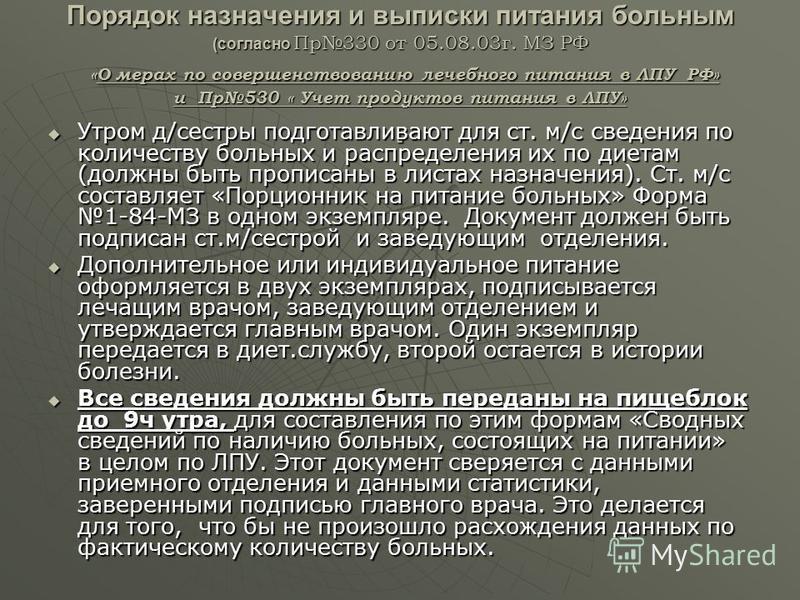
The procedure for prescribing and extracting food for patients. In accordance with the information received, the dietary nurse writes out a layout menu for the next day. In accordance with the information received, the dietary nurse writes out a layout menu for the next day. In the morning of the next day, the number of feeders is adjusted. In the morning of the next day, the number of feeders is adjusted. If the number of patients changes by more than three people (increase or decrease), an additional discharge or return of products is made. If the number of patients changes by more than three people (increase or decrease), an additional discharge or return of products is made. Newly admitted people eat according to the diet of the Department of Internal Affairs. Newly admitted people eat according to the diet of the Department of Internal Affairs.
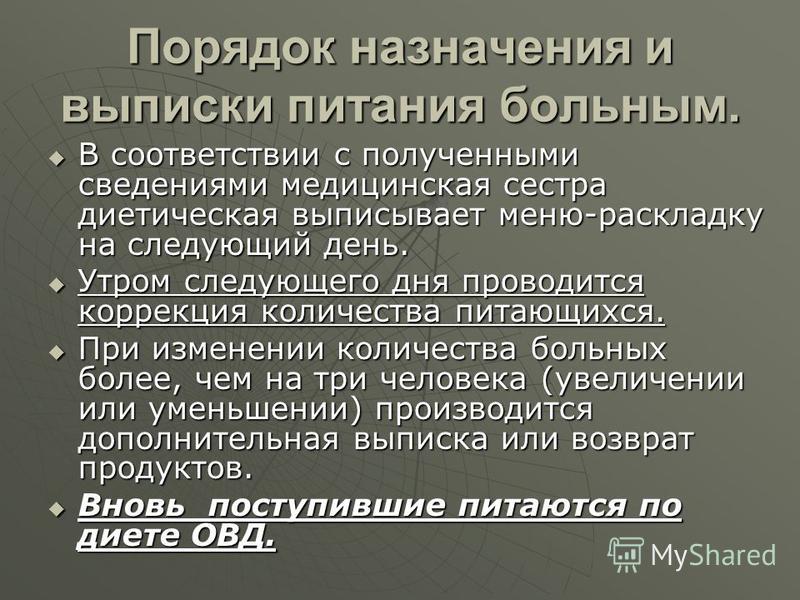
Cooked dishes are given out according to the distribution list (a very important document). Upon receipt of breakfasts, lunches and dinners, the employees of the departments (distributors-barmaids) sign for their receipt (by weight, according to the "output of ready meals" indicated in the layout menu), after which the responsibility for the safety and quantity of the received products passes to the departments. Cooked dishes are given out according to the distribution list (a very important document). Upon receipt of breakfasts, lunches and dinners, the employees of the departments (distributors-barmaids) sign for their receipt (by weight, according to the "output of ready meals" indicated in the layout menu), after which the responsibility for the safety and quantity of the received products passes to the departments. Distribution of food after 2 hours after its preparation is not allowed. It is strictly not allowed to leave food leftovers in the pantry after its distribution, as well as mix it with fresh dishes. Food is distributed only by barmaids and, if necessary, nurses on duty. Dressing gowns for food distribution only with special markings. Nurses are not allowed. Distribution of food after 2 hours after its preparation is not allowed. It is strictly not allowed to leave food leftovers in the pantry after its distribution, as well as mix it with fresh dishes. Food is distributed only by barmaids and, if necessary, nurses on duty. Dressing gowns for food distribution only with special markings. Nurses are not allowed.

The control of prepared food before issuing it to the departments is carried out by the doctor on duty and once a month - by the chief doctor (or his deputy for medical work) of the health facility, and is also carried out by a dietitian, dietary nurse, head. production (or chef) regardless of the sample produced by the doctor on duty. To familiarize patients with nutrition, the menu for today should be posted in a conspicuous place in the department every day. From Order 330 of the Ministry of Health of the Russian Federation "On measures to improve clinical nutrition in medical institutions of the Russian Federation" "On measures to improve clinical nutrition in medical institutions of the Russian Federation"

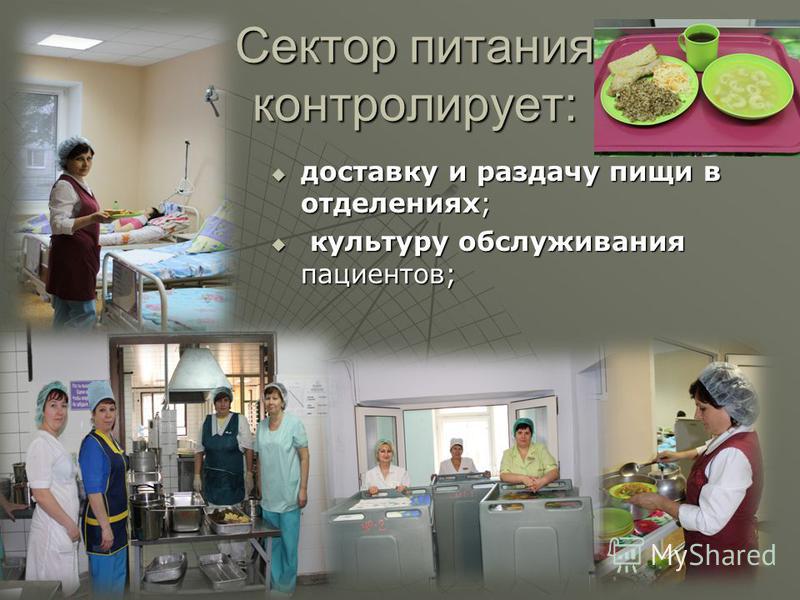
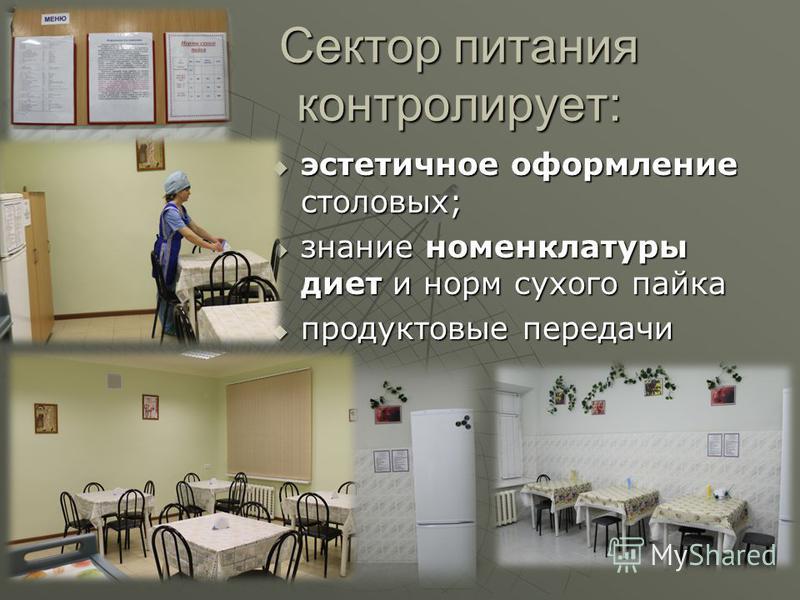
Topic: "SANITARY AND HYGIENIC CONTROL OF NUTRITION
IN HCI, SANATORIUMS, DIET-TABLES»
Educational and educational goals
common goal lessons- be able to conduct a hygienic assessment of nutrition in medical institutions based on knowledge of the principles of nutrition of a sick person.
Specific goals– be able to :
1) assess compliance with hygienic requirements when catering for patients in health facilities;
2) assess the sanitary condition and mode of operation of the catering unit and canteens;
3) to give a hygienic assessment of the state of control over the quality of prepared food in health facilities;
4) be able to take a sample for laboratory control over the quality of finished food;
5) monitor compliance with the rules of personal hygiene by catering workers.
know:
1) features of sanitary and hygienic control over nutrition in sanatoriums and diet tables;
2) the simplest instrumental control methods used in the practice of sanitary and food supervision.
List of practical skills that students must master
1. To master the content of the current sanitary control over nutrition in healthcare facilities, sanatoriums and dietary canteens
2. Be able to assess the sanitary condition and mode of operation of the catering unit
Issues to be studied
1. Hygienic requirements for catering for patients in medical institutions
2. Arrangement, equipment and maintenance of the food block of the hospital
3. Sanitary and hygienic regime of the catering department and pantry
4. Sanitary maintenance of equipment, inventory and utensils
5. The procedure for monitoring the quality of prepared food in health facilities
6. Sanitary and hygienic control over nutrition in sanatoriums and diet tables
Lesson time: 4 hours
Educational and material equipment
1. Thermometer with a scale of 100 0 C.
2. Rubber bulb or medical powder blower - 3 pcs.
3. Indicator papers impregnated with potassium iodine starch
4. Graduated tubes - 5 pcs.
5. Soft cotton swabs
Reagents:
1. 1% solution of phenolphthalein
2. 0.1N solution of hydrochloric acid
3. 0.5% solution of sodium bicarbonate
4. potassium iodine starch.
LITERATURE
Main:
1. Petrovsky K.S., Vanhanen V.D. Food hygiene- M .: Medicine, 1982. - S. 485-489, 517-520.
2. Vanhanen V.D., Lebedeva E.A. Guide to practical training in food hygiene- M., 1987. - S.236-246.
Additional:
1. Vorobyov V.I. Organization of diet therapy in medical institutions.- M: Medicine, 1983.
2. Hygienic requirements for the placement, arrangement, equipment and operation of hospitals, maternity hospitals and other medical hospitals- M., 2003, S.29-34. SanPiN 2.1.3.1375-03
3. Marshak M.S. Organization of therapeutic nutrition in hospital conditions– M.: Medicine, 1995.
4. Organization of therapeutic nutrition in health care facilities. Sanitary and anti-epidemic regime at catering units and buffet rooms- M., 1999.
5. Order of the Ministry of Health of the Russian Federation dated August 5, 2003 No. 330 " On measures to improve clinical nutrition in medical institutions of the Russian Federation».
6. Sivokhina I.K. Catering in healthcare facilities- M: RMAPO, 1997.
7. Smolyansky B.L., Abramova Zh.I. Health Nutrition Guide for Dietitians and Cooks– M.: Medicine, 1992.
8. Shchegoleva N.L. Organization of dietary nutrition in medical institutions// Chief nurse - 2003, No. 1. - P. 43-61
THEORY OF THE QUESTION
Hygienic requirements in the organization of nutrition of patients in medical institutions.
(SanPiN 2.1.3.1375-03)
1. Arrangement and maintenance of catering facilities, equipment, inventory, utensils, conditions for transportation and storage of food products must comply with sanitary rules for the organization of public catering
The operation of catering units of medical institutions is allowed if there is a sanitary and epidemiological conclusion.
2. The catering facilities of medical institutions must have the necessary set of production workshops that ensure compliance with hygienic requirements during the technological processes of cooking.
3. The flow of the technological process of cooking, incl. with the use of equipment in the work, should exclude the possibility of contact between raw and ready-to-eat products.
4. Food products entering the catering unit must comply with the hygienic requirements for food raw materials and food products, and be accompanied by documents certifying their quality and safety, indicating the date of production, terms and conditions of shelf life (storage) of products. The accompanying document must be kept until the end of the shelf life (storage) of the product. To control the quality of incoming products and their shelf life (storage), an organoleptic assessment is carried out and an entry is made in the product rejection log.
5. Storage of perishable products without cold is not allowed. Refrigerators must strictly adhere to commodity neighborhood rules. Raw materials and finished products should be stored in separate refrigerating chambers, as well as in the chamber for the daily supply of products, their joint short-term storage is allowed in compliance with the conditions of the commodity neighborhood (on separate shelves, racks). The conditions and terms of storage of products must comply with the requirements of sanitary rules.
6. In order to prevent the occurrence of infectious diseases and poisoning among patients of a medical institution:
a) not allowed to accept:
Food raw materials and food products without documents confirming their quality and safety;
Food raw materials and food products with expired shelf life, signs of spoilage and contamination; soaked products in soft containers (flour, cereals, sugar and other products);
Cereals, flour, dried fruits, products infected with barn pests, as well as contaminated with mechanical impurities;
Vegetables, fruits, berries with mold and signs of rot;
Meat and offal of farm animals without brand and veterinary certificate;
Meat and eggs of waterfowl (ducks, geese);
Ungutted bird;
Blood and liver sausages;
Eggs with contaminated shells, with a notch “tech”, “boy”, as well as eggs from farms that are unfavorable for salmonellosis;
Canned food, with a violation of the tightness of cans, bombed canned food, "crackers", cans with rust, deformed, without labels;
b) not used:
Flask, canned, unpasteurized milk, flask cottage cheese and sour cream without heat treatment (boiling), sour milk "samokvas";
canned food home cooking;
in) are not made at the catering department of a medical institution:
Cheese mass, cottage cheese;
pasta with minced meat(“in a naval way”), pancakes with meat, jellies, brawns, okroshka, pates, minced herring, jellied dishes (meat and fish);
Fried eggs;
Creams, cream confectionery;
Deep-fried products, pates.
7. When compiling menu layouts, the basic principles of compiling diet menus, as well as nutritional norms per patient in the prescribed manner, should be taken into account.
The nutrition of patients should be varied and correspond to medical indications in terms of chemical composition, nutritional value, a set of products, a diet.
When developing a planned menu, as well as on the days of replacing products and dishes, the chemical composition and nutritional value of diets should be calculated.
8. The processing of eggs used for cooking is carried out in accordance with the requirements of the established sanitary rules for catering establishments. Storage of raw eggs in cassettes, boxes in production shops is not allowed.
9. Washing side dishes made from pasta and rice is not allowed.
10. Stainless steel utensils should be used for preparing and storing cooked food. Aluminum utensils can only be used for cooking and short-term storage of dishes. It is not allowed to use enamelware for cooking and storing dishes.
11. Issuance of ready-made food is carried out only after sampling. In case of violation of the cooking technology, as well as in case of unavailability, the dish is not allowed to be served to eliminate the identified culinary shortcomings. The result of the grading is recorded in the finished product grading log.
12. In order to control the good quality and safety of cooked food at the food units of medical institutions, a daily sample is taken from each batch of cooked dishes.
A daily sample is taken by a medical worker (or a cook under his supervision) in specially designated sterile and labeled glass containers with tight-fitting lids - each dish or culinary product separately. Cold appetizers, first courses, side dishes and drinks (third courses) are selected in an amount of at least 100 g. Portioned main courses, meatballs, meatballs, cheesecakes, pancakes, sausage, sandwiches are left individually, whole (in the amount of one serving).
Daily samples are stored for at least 48 hours from the end of the period for the sale of dishes in a specially designated place in the refrigerator at a temperature of +2 + 6 0 С.
Vessels for storing a daily sample (containers and lids) are boiled for 5 minutes.
13. For transportation of prepared food to the pantry departments of a medical institution, thermoses or tightly closed dishes are used. Bread can be transported in polyethylene or oilcloth bags, storage of bread in which is not allowed.
14. When serving dishes for buffet departments at the catering department, the temperature of the prepared food should be: the first - not lower than 75 0 С, the second - not lower than 65 0 С, cold dishes and drinks - from 7 to 14 0 С.
Until the moment of distribution, the first and second courses can be on a hot stove for no more than 2 hours.
15. At the catering unit during the expedition, a room should be allocated for washing and storing kitchen utensils from the compartments (thermos, pots, buckets, etc.). In this room, it is not allowed to wash and store kitchen utensils of the catering unit, as well as utensils from infectious diseases departments.
It is allowed to wash and store pantry kitchen utensils in washing pantry departments, in the absence of conditions at the catering facility. To do this, it is necessary to provide for the additional installation of a bath of the required standard sizes and a place for storing kitchen utensils.
16. For transportation of food products from bases, shops, as well as for the delivery of ready-made meals to departments, vehicles with a sanitary passport must be used.
17. In all dish-washing premises (including canteens) backup electric water heaters with water supply to the washing baths must be installed.
18. For processing dishes, it is necessary to use detergents, cleaners and disinfectants that are approved for use in medical institutions in the prescribed manner. In the washing departments, instructions are posted on the rules for washing dishes and equipment, indicating the concentrations and volumes of detergents and disinfectants used.
19. There should be two rooms in the pantry departments: for serving food (at least 9 m 2) and for washing dishes (at least 6 m 2). In the room for processing dishes, 5 sinks are installed with cold and hot water supply to them with a mixer.
19.1. The distribution of ready-made food is carried out within 2 hours after its manufacture and the time of delivery of food to the department;
19.2. It is not allowed to leave food leftovers in the pantry after it has been distributed to the sick, as well as to mix food leftovers with fresh dishes.
19.3. Food is distributed to patients by barmaids and duty nurses of the department. The distribution of food must be carried out in dressing gowns marked "For the distribution of food." Junior service personnel are not allowed to distribute food.
19.4. In the places of reception of transfers and in the branches, lists of products allowed (with an indication of their maximum number) for the transfer of products should be posted.
19.5. Every day, the duty nurse of the department should check compliance with the rules and expiration dates (storage) of food products stored in the refrigerators of the department and bedside tables of patients.
If food products are found with an expired shelf life (storage), stored without plastic bags (in the refrigerator), without indicating the name of the patient, and also with signs of spoilage, they should be removed as food waste. The patient should be informed about the storage rules upon admission to the department.
DEVICE, EQUIPMENT AND HYGIENE
FOOD UNIT HOSPITALS
Food unit - This is a complex of special premises in which food products are delivered from food bases, where they are stored, primary (cold) and thermal cooking and distribution of prepared food are carried out. The catering units of hospitals and dispensaries, maternity hospitals consist of a food preparation service and canteens with canteens in the ward departments. Cooking Service is a complex of warehouse, production, service and household (for personnel) premises. The catering units of hospitals are centralized and decentralized (in hospitals with 600 or more beds).
Centralized catering unit(central kitchen) are located:
A) inside a common building - in single-unit hospitals with up to 300 beds;
B) in a separate building - in large multi-building hospitals;
The basic principle of planning the catering unit of the hospital is adherence to the principle of flow all processes of transportation, storage and preparation, as well as the sale of food products and prepared food and the absence of adverse counter flows (raw products and semi-finished food products and their waste, the flow of staff and visitors - in diet tables), the possibility of creating hygienic conditions to maintain the sanitary regime of the enterprise up to the mark. According to building codes and regulations, the set and area of premises for the food preparation service depend on the capacity of the hospital, i.e. the number of beds in it. The centralized kitchen of hospitals with 100-600 beds includes the following premises:
Warehouse: refrigerated chambers for meat, fish, dairy products and fats, fruits and herbs, canned food, eggs, ferments, waste (with a separate entrance). Unrefrigerated pantries for vegetables, dry foods, bread.
· Production: preparation shops for vegetables, meat, fish; confectionery shop, cold shop, hot (brewing) shop with distributing.
· Expedition.
· Ancillary: washing of kitchen utensils, daily supply pantry, cabinet for storing cleaning equipment, for storing and washing carts.
· Auxiliary: linen pantry, container pantry, loading room, storekeeper's room, inventory pantry - closet.
· Administrative and domestic: a room for a dietitian, a dietitian-head of a catering unit, showers, latrines.
With a decentralized food unit(in hospitals with 600 or more beds) there is a centralized procurement room, where semi-finished products are prepared, and pre-cooking kitchens of medical buildings, from where prepared food is dispensed directly to patients (the disadvantage of centralized catering units is that food is shifted from one dish to another, reheated, which is reflected on its taste and other qualities, can become infected if the rules of transportation are violated).
Centralized procurement of a decentralized catering unit consists of the following rooms:
A) warehouse - refrigerated chambers for the separate storage of meat, fish, dairy products, fruits and herbs, waste (with a separate external entrance); separate pantries for vegetables, bread, dry products, fermented foods, as well as linen and inventory; container, loading;
B) production - separate workshops for the preparation of vegetables, meat, poultry, fish, a confectionery workshop, a washing of kitchen utensils, an expedition of the main and infectious diseases buildings, washing containers;
C) office and household - a room for the production manager and staff, a storekeeper's room, a personal hygiene room for staff, latrines for staff, a dressing room with a shower.
Pre-cooking kitchens of medical buildings at a decentralized catering unit, they consist of the following premises: a pantry for a daily supply of food, a bread slicer, a pre-cooking room, a cooking room, a washing of kitchen utensils, a cold storage room, a pantry for cleaning items, a room for storing and washing food warmers, a room for a dietitian (nutritionist) and staff, dressing rooms, showers and latrines for staff with a personal hygiene room. In departments of hospitals, pantry and canteen-pantry rooms are equipped in infectious, tuberculosis and dermatovenerological departments should have two rooms separated by a partition: one communicates with the outside entrance and is intended for personnel delivering prepared food from the kitchen; another for the personnel in charge of the distribution of the latter. The canteens of infectious diseases and tuberculosis hospitals are equipped with sterilizers for processing tableware and create conditions for the disinfection of food residues. Their area is 25 sq. m. In most other departments, the pantry area is 18 sq. m. m.
The catering unit should have sufficient usable area and be provided with all necessary equipment, allowing to observe the principles of production flow.
Perishable products are stored in refrigeration units equipped with thermometers. It is important to ensure that the storage temperature of these products does not exceed 6 0 C. In refrigerators or cold rooms, places are marked for the separate storage of products such as meat, fish, milk and dairy products, etc. Products for children of the first year of life (pumped breast milk, liquid milk mixtures) are placed in separate refrigerators.
Bulk products require separate rooms equipped with special shelves, racks or cabinets. Vegetables are stored in a special well-ventilated pantry or vegetable store.
In the neighborhood of the warehouses, separate preparation shops of the catering unit are located for processing raw and cooked products. Their equipment must correspond to the technological process (production tables, racks, tool cabinets). The workshop for the primary processing of vegetables must have a potato peeler, a vegetable washing machine, and washing baths. The harvesting vegetable workshop is equipped with a machine for cutting and rubbing vegetables, marked boards and cutting tools with the appropriate marking.
In the meat and fish shop of primary processing, the initial preparation of Meat, fish, poultry for subsequent cooking is carried out. The second stage of preparation of these products is carried out in the procurement workshop, where semi-finished products are prepared.
In the hot shop, heat treatment and final preparation of dishes are carried out. In this workshop, in addition to gas or electric stoves, there is the necessary set of kitchen utensils and cooking pots for preparing various dishes. All utensils must be labeled and used only for their intended purpose.
Depending on the capacity of the hospital, the catering department also provides for such special facilities as a confectionery shop for the preparation and baking of confectionery, a vitamin shop for the preparation of fruit and vegetable juices and drinks.
Next to the hot shop there is a washing room for kitchen utensils, equipped with special baths with cold and hot water supply and connected to the sewer with a mandatory air break device. It is important to ensure that dirty and clean dishes do not touch in this workshop. To store clean dishes, you must have a special room or place.
The technological equipment of the catering unit is divided into mechanical, thermal and refrigeration.
1. mechanical equipment used for primary processing of products, it includes:
a) machines for processing cereals, potatoes and vegetables (grinders, potato peelers, vegetable cutters, shredders, mashers, juicers);
b) machines for processing meat and fish (meat grinders, meat mixers, special devices for cleaning fish from scales, cutlet machine, saws for sawing meat carcasses);
c) machines for preparing dough (sifters, dough mixers, a mechanism for laying out and dividing dough);
d) dishwashing machines (or tubs for hand-washing tableware and tubs for washing kitchen utensils);
e) machines for cutting bread, egg cutters;
f) beater for liquid mixtures.
2. Thermal equipment it is used for thermal processing of products (cooking, frying, baking, steaming, combined processing).
a) to cooking equipment include cooking kettles, gravy kettles, steamers, egg and sausage boilers;
b) to frying equipment include electric frying pans, electric crucibles, electric stoves, microwave ovens. Ovens (with T-150-200 0); drying cabinets (T-100-150 0), baking cabinets (T-up to 300 0).
3. Non-mechanized equipment:
a) cutting tables, cutting boards, racks, carts, scales, cabinets for storing kitchen utensils and appliances, chests, cutting decks;
b) pots, buckets, baking sheets, frying pans, sieves, vessels, kettles;
c) inventory: knives, forks, spatulas, mortars, molds, strainers, skimmers, etc.
4. Refrigeration equipment represented by refrigerated chambers and refrigerated cabinets.
5. The premises of the pantry at the departments of medical institutions should be provided with:
a) cold and hot running water, regardless of the availability of hot water supply; canteens should be equipped with continuous electric boilers;
b) two-section washing baths that are connected to the sewerage, a tank for soaking (disinfection) or boiling dishes;
c) washing disinfectants;
d) nets for drying dishes, appliances and food storage (bread, salt, sugar);
e) a cabinet for storing household equipment;
f) food warmer or electric stove for heating food;
g) a table with a hygienic coating for distributing food;
h) a table for dirty dishes;
i) a set of dishes per patient: one deep, small and dessert plates, a fork, spoons (table and tea), a mug, and in children's departments with a margin, according to the equipment sheet;
j) cleaning equipment (buckets, rags, brushes, etc.) marked “for pantry”.
Responsibility for the correct equipment of the catering unit and buffet departments of the medical institution is borne by the deputy chief physician for the administrative and economic part and the dietitian.
Transportation of prepared food
A) in the absence of a centralized ring delivery of food products, special transport (covered) is allocated for their transportation, which is subjected to certification at least once a year in the institutions of the state sanitary and epidemiological supervision. It is strictly forbidden to use this transport for other purposes (transportation of linen, equipment, patients, etc.);
B) for the transportation of prepared food to the pantry departments of the hospital, thermoses, thermos carts, food warmer carts or tightly closed dishes are used.
Responsible for compliance sanitary requirements when preparing and dispensing ready-made food in the catering department is the head. production (chef), a dietary nurse, a dietitian, and in the department - barmaids and senior nurses.
Sanitary and hygienic regime of the catering department and pantry
1. In the food blocks of medical institutions, the following must be strictly observed:
Requirements for the arrangement of the catering unit, sanitary maintenance and cooking technology, provided for by the current sanitary rules for public catering establishments;
Sanitary rules on the conditions and terms of storage and sale of especially perishable products;
Requirements for mandatory preventive and medical examinations of catering, distributing and buffet workers (forms 1-lp and 20-lp).
It is strictly forbidden in the premises of the catering unit to wash tableware from the departments of the medical institution. Washing of dishes is carried out only in the washing cupboards of the departments in compliance with the disinfection of dishes.
The distribution of ready-made food is carried out no later than 2 hours after its preparation, including the time of delivery of food to the department.
Food is distributed to patients by barmaids and duty nurses of the department. The distribution of food should be carried out only in a dressing gown marked "For the distribution of food."
Technical personnel involved in cleaning the wards and other premises of the department are not allowed to distribute. Meals for all patients of the department, with the exception of seriously ill patients, are carried out in a specially allocated dining room. Personal food products of patients (transfers from home) are stored in a closet, bedside table (dry products) and in a special refrigerated cabinet (perishable products).
Transfers to patients are accepted only within the range and quantity of products permitted by the doctor.
After each distribution of food, the premises of the pantry and dining room are thoroughly cleaned using disinfectant solutions.
After washing, the cleaning material is poured with 0.5% clarified bleach solution or 1% chloramine solution for 60 minutes, then rinsed in running water and dried (the inventory is used strictly for its intended purpose).
Strict observance by all employees of the catering department of the rules of personal hygiene has great importance to prevent bacterial contamination of food, cases of food poisoning and acute intestinal diseases.
Before starting work, the staff of the catering unit is required to undergo a course of a sanitary minimum and a medical examination.. Regular classes on the sanitary minimum are also held in the future, both with catering workers and with barmaids of departments.
Each employee must have a medical book, in which the results of medical examinations, information about the transferred infectious diseases, about passing the sanitary minimum are entered.
All employees of the catering unit undergo a daily medical examination for the presence of pustular diseases. Workers with suspected illness and sick people are not allowed to work.
All work in the catering unit is carried out in overalls, which are changed as they get dirty, but at least 1 time in 2 days. When an employee moves from the processing of raw products to work with finished products, it is necessary to use appropriate protective clothing. Overalls should not be fastened with pins or needles; it is forbidden to store foreign objects (cigarettes, keys, money, etc.) in the pockets of overalls. Catering workers must not wear beads, brooches, rings, clip-on earrings, etc.
Before starting work, you must thoroughly wash your hands, change shoes, put on overalls, carefully pick up your hair under a cap or scarf. At the end of the work, the overalls are placed in a special closet. When using the toilet, it is removed and put on only after thorough washing and disinfection of hands.
At the end of the work on the catering unit, the room is thoroughly cleaned. Cleaning is carried out in a special (dark) dressing gown using special cleaning equipment. Cleaning equipment, a cleaning gown, detergents are stored in a specially designated place and are not used for cleaning other premises. It is necessary to have a separate bathrobe and other cleaning equipment for cleaning the toilet at the catering unit.
All premises of the catering unit must be kept in perfect cleanliness. Daily cleaning consists of washing floors as they get dirty, removing dust, wiping heating radiators, window sills, washing tables and cutting boards after each stage of work is completed, as well as timely washing dishes and kitchen utensils.
At least once a week, the premises of the catering unit are treated with detergents, walls, lighting fixtures, window panes, etc. are washed. Conducted once a month general cleaning with subsequent disinfection of all premises, equipment and inventory.
To fight flies, cockroaches, rodents, only mechanical means of their extermination are allowed. The use of chemical and bacteriological preparations for this purpose is prohibited.
Sanitary maintenance of equipment, inventory and utensils
Compliance with sanitary and hygienic requirements for the maintenance of equipment, inventory and utensils plays an important role in the prevention of food poisoning, infections, and helminthic diseases. Washing machines and washing baths are used for washing dishes. Regardless of the presence of a dishwasher, 5-hole washing bathtubs are equipped in the washing room. Taking into account the capacity of the catering unit (canteen), washing of kitchen and tableware is carried out in different rooms or in a common, divided screen. Washing provide hot water from a water supply network or a continuous boiler. For washing and disinfection, preparations are used according to " The list of detergents and disinfectants approved for equipment, inventory and utensils intended for contact with food».
Processing of tableware, tea utensils and cutlery should be carried out separately in the following sequence:
When processing tableware, mechanical removal of food and washing of dishes is carried out in the first wash with degreasing agents in a solution with a water temperature of 50 0 C, in the second wash - with disinfectants in the manner established by the Ministry of Health of the Russian Federation, in the third wash - rinsing of hot flowing dishes water with a temperature not lower than 65 0 C, drying dishes on special shelves or grates;
When processing tea utensils and cutlery, food is mechanically removed and utensils are immersed in a solution with degreasing and disinfecting agents;
To disinfect dishes, instead of disinfectants, you can use the boiling method for 15 minutes.
In infectious medical institutions or in the event of cases of infectious diseases in non-infectious departments, the sequence of processing utensils, the means and methods for its disinfection, as well as the disinfection of food residues from a patient with various diseases, are carried out in the manner established by the Ministry of Health of the Russian Federation.
Kitchen utensils in pantry departments are washed with hot water at a temperature of at least 50 0 C, rinsed with running hot water at a temperature of at least 65 0 C, drying dishes on special shelves or grates.
Washcloths for washing dishes and rags for wiping tables after cleaning are boiled for 15 minutes or soaked in disinfectant solutions.
Equipment washing mode . At the end of work, all working, metal parts of the machines are disassembled, cleaned of food debris, washed with the addition of detergents, scalded with boiling water, dried in an oven or wiped dry with a clean cloth. Small parts, except for cutting parts (meat grinder knives, shredding machines), can be calcined in an oven or boiled for 10 minutes.
Inventory washing mode . Metal inventory after washing with detergents and rinsing is calcined in the oven. Wooden equipment (chopping boards, spatulas, stirrers) is cleaned of food debris, washed with water (50 degrees C) with detergents, rinsed with water (at least 65 degrees C) and dried on metal lattice racks. For complete disinfection, cutting boards are boiled for 10 minutes in a 2% solution of soda ash or for 15-20 minutes without soda. Glue cutting boards cannot be boiled, they are washed with a 2% hot solution of soda, wiped with a 0.2% solution of bleach or chloramine and rinsed with hot water after 30 minutes. Cutting tables with a metal surface are washed with warm water and soap or detergents and poured over with hot water. A sieve, cheesecloth, through which the broth and juices are filtered, pastry bags for cream are washed in hot water with detergents, rinse, boil for 15 minutes and, after drying, store in a closed labeled container. Brushes, washcloths for washing dishes after work are washed with detergents, boiled for 10-15 minutes, dried and stored in a specially designated place. Trays for dining tables are washed with hot water and detergents, rinsed, wiped with marked napkins. Clean and dry dishes and utensils are put into cupboards, thermoses and containers are washed separately from kitchen utensils in special baths or in a separate room. At thermoses, first wash the outer, and then the inner surfaces, then rinse with hot water. If steam is provided, thermos-washers are organized. After use, washing baths are washed and doused with boiling water, and washing machines are cleaned after work, washed with hot water and soda and wiped dry. Tanks for collecting waste and garbage are cleaned after filling - no more than 2/3 of the volume (after operation, the tanks, regardless of the filling volume, are cleaned, washed with a 2% solution of soda ash, rinsed with hot water, and dried). Food waste containers are washed with a 2% soda solution and disinfected with a 10% clarified bleach solution. The dietitian and the head of production - the chef control the quality of washing dishes, equipment and inventory, paying special attention to the frequency of changes and the temperature of the water in the washing baths, the dosage of detergents and disinfectants.
The organization of clinical nutrition as a whole consists of the following main sections that require specific implementation in each medical institution:
- clinical issues of the organization, which include the principles of building therapeutic nutrition, the system of its appointment, diet and nutritional norms.
- sanitary and technological issues of the organization, which includes the system for building food blocks and transporting food, equipment and inventory, sanitary requirements for the maintenance of the food block.
- management of clinical nutrition and training.
- technical issues of the organization, covering the methods of compiling the menu, the system of accounting for prescriptions, the discharge of products, the organization of the technological process in the kitchen, the system for issuing food from the kitchen, food quality control and the organization of patient care.
Principles of construction and system of prescribing medical nutrition
In accordance with the physiological principles of building food rations, medical nutrition is built in the form of daily food rations. Each daily diet of the patient, in other words, his diet, has its own energy value, i.e. calorie content, chemical composition(a certain amount of proteins, fats, carbohydrates, mineral salts, water, vitamins, extractives and other substances), certain physical properties: weight (volume), texture, food temperature and, finally, a certain mode (routine) of nutrition. All these are elements of the diet, which are practically implemented in the form of a menu consisting of appropriate products with a certain culinary processing.
When prescribing therapeutic nutrition, two systems can be used: elemental and dietary. With the elemental appointment of therapeutic nutrition for each patient, a prescription is made with a specific enumeration of the indicators of each of the elements of the daily diet; Based on this recipe, a daily menu is compiled. This system is called individual, but such a definition is not entirely correct, since a properly organized therapeutic diet necessarily requires an individual diet. If, under the elemental system, the doctor develops an individual diet for each patient, then under the dietary system, he prescribes on an individual basis one or another diet from among those previously developed, clinically tested and having certain medicinal properties. Therefore, it is wrong to call the dietary system of prescribing therapeutic nutrition "group".
The main system in medical and treatment-and-prophylactic institutions, i.e., when servicing significant contingents of patients, is the dietary system for prescribing therapeutic nutrition. The elemental system can be practically used only in isolated cases, when it is necessary to make many amendments to one or another diet developed and used in a given medical institution, taking into account the complexity and special conditions of the course of the disease in the patient.
With a dietary system, it is also possible to make certain adjustments to the prescribed diet in connection with special indications. Such additional appointments or restrictions in the diet should be made by prescribing products with certain medicinal properties (cottage cheese, liver, milk, watermelon, apples, garlic, etc.), or by adding or limiting nutrients (proteins, fats, carbohydrates, salts, vitamins). With the additional appointment of special products, it is necessary to correspondingly reduce the content of other products in the diet in order to maintain mainly the chemical composition and calorie content of the diet.
In medical institutions of the Soviet Union, diets developed in the clinical nutrition clinic of the Institute of Nutrition of the USSR Academy of Medical Sciences, approved by the USSR Ministry of Health, are used. The most commonly used diets are numbered; some diets and so-called contrast or fasting days are indicated by the name of the product, such as sugar, apple, compote day.
Each diet has its own characteristics (see below). The number of diets to be introduced in the hospital is determined by the profile of the institution, i.e., the main contingent of hospitalized patients. Every hospital should establish basic, continuous diets and contrast days; as needed, other diets can be used, and in isolated cases, therapeutic nutrition is prescribed according to the elemental system. Practically in a multidisciplinary general hospital, 7-8 diets and contrast days are constantly used.
The mode, i.e., the diet of patients, is essential for the effective action of therapeutic nutrition. The diet consists of the number of meals, the time of meals for patients, the nutritional value and the amount of food taken at each time.
The Ministry of Health of the USSR established for hospitals at least a four meals a day, for some groups of patients (with heart disease, stomach ulcers, for infectious patients, etc.) it is necessary to establish a five to six meals a day. You should strive for a more or less even distribution of the daily ration, but in any case, avoid a significant amount with a high calorie content for dinner; as a rule, the evening should not account for more than 25-30% of the daily caloric intake. The feeding time of patients is determined by the number of meals and the general daily routine in the medical institution. Between separate meals, a break of more than 4 hours in the daytime should not be allowed, and between the last evening meal and the morning breakfast, the break should not be more than 10-11 hours. In this regard, it is advisable to organize the 4th meal with a four-time meal not in the form of a second breakfast or afternoon snack, but in the form of a small meal 1-2 hours before going to bed (second dinner). Thus, the main mode of four meals a day is presented in the following form.
With a five-time meal, a second breakfast is introduced, and with a six-time meal, an afternoon snack is also introduced with a more or less even distribution of the daily ration.
Hot food should be included in. each of the meals. The temperature of liquid hot meals should be about 60°, and the second hot dishes should be about 55° when served to patients. The temperature of the food in the department must be carefully controlled.
The norm of the daily diet is set in the characteristics of each diet. As mentioned above, the chemical composition and calorie content of each diet is provided by the appropriate set of products. Based on the food package and the degree of use of each of the diets used in the hospital, the need of the medical institution for food supply is determined. The guidelines for the food supply of hospitals, which determine appropriations for food, have been established by the USSR Ministry of Health in the following volume.
Nutritional norms in urban and rural hospitals per patient per day
Nutritional value: proteins 88 g, fats 66 g, carbohydrates 459 g, which is 2889 calories. The actual nutrition of patients is improving both quantitatively and qualitatively through the development of hospital subsidiary farms. Nutritional value is affected by food "transfers", which must be clearly regulated.
Sanitary and technological issues of the organization
The organization of the food block in the hospital can be carried out according to a centralized or decentralized system. The food block according to its composition can be divided into the following main groups of premises: 1) for food storage; 2) for cooking (semi-finished and prepared food); 3) to release food from the kitchen; 4) for the distribution of prepared food to patients and its reception in hospital departments. In addition, the complex of the food block includes auxiliary premises (inventory, linen, container, for storing waste), maintenance premises (boiler room, workshop), premises for personnel (administrative and sanitary) and a food laboratory.
With a centralized system, the entire food block, except for the premises for distributing food to the sick (pantry rooms) and for its reception (dining rooms), is concentrated in one place. From the central kitchen, prepared food is delivered to the pantry in group transport dishes, where it is distributed among the sick. With this system, prepared food is distributed 2 times: the first time in the kitchen in group dishes and the second time in the pantry, where food, often reheated, is distributed in individual dishes.
With a decentralized system, prepared food is released to patients directly from the kitchen in individual dishes, which is achieved by bringing the cooking process as close as possible to the place of stay of patients, i.e., to the hospital department. In a single-unit hospital, a food unit is arranged in a hospital building, and in a multi-unit hospital, in each hospital building with 50 beds or more, a pre-cooking kitchen is organized, and in a separate building or in one of the hospital buildings, centralized storage of products, preparation and dispensing of semi-finished products. A decentralized system has a number of advantages compared to a centralized one: repeated rearrangement of food, its cooling and loss of shape, reheating are avoided, due to which the taste of food, its hygienic properties do not deteriorate, and more favorable conditions are created for organizing therapeutic nutrition. The head of the department and the attending physicians get the opportunity to influence the nutrition of patients, the workers of the food block can be responsible for the entire process of nutrition, up to the moment the patients actually eat.
When designing new hospital construction and reconstructing existing hospitals, the USSR Ministry of Health provides for the organization of food blocks according to a decentralized system. It is also necessary that in existing hospitals, in which food blocks are located in the hospital building, to organize the nutrition of patients according to a decentralized system, i.e., deliver food to patients directly from the kitchen in individual dishes, and not distribute it to pantry in group dishes and transfer it to plates.
Questions of hygienic maintenance of the food unit and sanitary requirements for the technological process of cooking are set out above (p. 29).
Hospital nutrition management
The general management of nutrition is carried out in the hospital by the chief physician or his deputy for the medical part, and in the departments - by the heads of departments. To coordinate all the work on the use of clinical nutrition in multidisciplinary hospitals, a Medical Nutrition Council is being created, which discusses and outlines activities on the main issues of organizing clinical nutrition. The council includes heads of departments, a supply manager, a dietician, a dietitian (head of the kitchen), a senior cook and a dietitian of the department, appointed by the chief physician. The chairman of the council is the chief physician of the hospital, and the executive secretary is a dietitian. The direct scientific, methodological and organizational management of clinical nutrition in the hospital is carried out by a dietitian. In hospitals where the position of a dietitian is not provided, the management of therapeutic nutrition is entrusted to one of the attending physicians.
The management of the hospital kitchen is entrusted to a dietitian working under the medical direction of a doctor. The functions of a dietitian (head of the kitchen) include control over the sanitary and hygienic and technological process in the kitchen, the correct release of food from the kitchen; she organizes the distribution of food in the canteens.
Direct cooking is carried out under the guidance of a senior cook-foreman, who, like the rest of the production staff of the kitchen, works under the guidance of a dietitian. The position of a dietitian is established according to the staffing standards of the USSR Ministry of Health for every 200 beds (half of the position for every 100 beds), so that in large hospitals it is possible to lead the work on feeding patients in separate buildings also by dietitians. In departments where there are no dieticians, the organization of food for patients is entrusted to the elder sisters of the department. In tuberculosis and infectious diseases hospitals, for every 100 beds, a position of a dietitian is provided, and from 75 to 100 beds - half the position, i.e., half-time.
Provision of the food block with products, inventory, hiring and dismissal of kitchen staff are carried out by the deputy chief physician for the administrative and economic part.
The functions of the Council for Clinical Nutrition in a hospital, a dietitian and a dietitian (head of the kitchen) are provided for in special "Regulations" approved by the USSR Ministry of Health.
Systematic work to familiarize all hospital staff with the basics of clinical nutrition plays essential role in hospital catering. This work should be organized by a nutritionist with the involvement of a dietician and a senior cook, as well as hospital doctors.
The characteristics of the basic, permanent diets should be introduced to doctors, nurses and all kitchen production personnel. Organization is very valuable. special classes with a demonstration of the technology of preparing main dishes. The junior medical staff of the hospital should also be familiar with the basic diets and principles of serving patients with therapeutic nutrition. It is necessary to include classes on a sanitary minimum in the training plan for the production staff of the kitchen.
The technical minimum for therapeutic nutrition and sanitation must be passed by all newly hired employees of the food unit, directly related to the process of storing and preparing food products.
Technical issues of the organization of clinical nutrition
Menu compilation. Applications for food of patients are made in the reception and hospital departments and daily until 13-14 hours are transferred to the dietitian. The application from the admission department is valid on the day of admission of the patient and the next day, if the patient was admitted to the medical institution in the afternoon. Based on the applications received for various diets, the dietitian, with the participation of the senior cook, draws up a menu-portion and transfers all the material to the counting department, where the necessary products are calculated, and demanding statements are written out to the pantry.
The main document on the basis of which the extract and cooking is made is the menu-portioner (pay slip). The menu-portioner is signed by a nutritionist, under whose leadership the menu is compiled by a dietitian (head of the kitchen), an accountant (calculator) and approved by the chief physician.
The number of products in the portioning menu is written as a fraction: in the numerator for one serving, in the denominator for all servings. It is not required to indicate the number of products per serving if there is a card file of dishes, in which the card of each dish has its own number and set of products; in this case, it is enough to indicate the number of the dish, its name and the number of servings in the portioning menu; the counting part, where there should be a copy of the card index of dishes, counts the required number of products, guided by the number and name of the dish, affixed by the dietitian in the portion menu.
According to the menu-portioner, as a rule, products are prescribed that are to be processed in the kitchen; bread, butter, sugar, tea, sold to patients without cooking, are obtained from the pantry directly by the barmaids of the departments according to individual requirements, compiled by the counting part; since the norm of bread, sugar and butter is not the same in different diets, each hospital establishes the norm of these so-called buffet products for the main diets: the norm is approved by the head physician and serves as the basis for issuing requirements for these products.
In each medical institution, a planned seven-day menu should be developed for basic, permanent diets. It should correspond to the characteristics of diets, provide a variety of delicious meals, the right combination of foods at each meal, and be in line with the food allocations available in the institution.
For each of the main meals: breakfast, lunch and dinner, the menu should include dishes that would ensure the content of proteins, fats and carbohydrates in it. It is necessary to avoid that both the soup and the side dish for the second course at lunch consisted of cereals and flour products (pasta, vermicelli). Simultaneously with the planned seven-day menu, layout cards for individual dishes are compiled. The layout cards are compiled on the basis of the materials given in this manual and other published materials, with amendments due to the practice of this medical institution.
The cards are compiled in two copies, one of which is stored in the dietitian's file cabinet, and the second in the counting part.
When compiling the menu, you should take into account the time required to prepare the dish, and the permissible shelf life of it after readiness. This helps cooks plan their work to prevent the loss of nutritional value and taste of dishes from excess storage in the finished form. So, for example, legume dishes that require a long cooking time cannot be included in the breakfast menu, and the number of fried dishes that quickly lose their taste during storage must be combined with the production capacity of the stove. The cook who is entrusted with the preparation of certain dishes should be instructed about the time and sequence of their preparation.
Quality control of products and prepared meals. Quality control of raw materials and finished food should be carried out systematically at certain stages of the technological process, and at certain stages the results of the check should be documented.
The first stage of control is to check the good quality of products when they arrive at the warehouse. In addition to the storekeeper responsible for the quality of the products received, all products received at the warehouse are examined by a doctor on duty or a dietitian, and the results of the examination are recorded in a special journal of the following form.
The second stage of control is to check the quality of products when they are released from the pantry. When food is dispensed to the kitchen and pantry, the head of the kitchen or the senior cook and barmaids of the departments are present. No recording is made. In case of doubts about the good quality of the products, the question is resolved by a dietitian or a doctor on duty.
In the process of cooking, the yield of semi-finished products after the primary processing of meat, poultry, fish, potatoes and the quality of the finished food before it is released to the sick are checked.
The output of semi-finished products is recorded in the production log of the following form.
| the date |
Product name | Gross weight | Waste weight | Net weight | Waste percentage | Signatures | |
| food (bones, caviar) |
non-food (scales, intestines, etc.) | ||||||
Weighing of semi-finished products is carried out with the participation of a member of the public, a doctor on duty or a dietitian.
An entry in the production journal is the basis for issuing additional products in case of substandard raw materials and returning excess raw materials received to the pantry in comparison with the norm for laying the product - net.
Quality control of prepared food is carried out in the kitchen by the doctor on duty together with the head of the kitchen. With a centralized food block system, food is also examined in the pantry by a doctor or the head nurse of the department. The results of a sample of prepared food in the kitchen are recorded for each dish in the portioning menu, where special columns are provided for this, and the overall assessment is entered in the prepared food sample log of the following form.
The release of food from the kitchen to the departments with a centralized food block system. The barmaid or the nurse of the department should, before each meal, appear at the kitchen expedition to get acquainted with the menu, the weight of the prepared dishes and receive instructions on distributing food to the sick. It is advisable to carry out the delivery of food to the pantry by the kitchen. When sending food to the pantry at the departments, it is necessary to stick pre-prepared labels on each dish indicating the number of the diet and the number of dishes; all food should be sent to each compartment at the same time.
Distribution of food in the cafeteria. Each pantry should have facilities for heating food. The rapid distribution of food is essential to prevent its cooling. Therefore, free personnel should be involved in the distribution of food to patients, providing them with proper sanitary clothing. It is necessary to provide the department with a sufficient number of cutlery (at least one cutlery for each patient); it is advisable to heat the plates before filling. First of all, individual dishes should be distributed, and then mass ones. At first, bed patients are served, and then patients who eat in the dining room. In the pantry, a menu should be posted indicating the weight of the portions. In order to avoid errors in the distribution of food to bed patients, a label should be hung on each bed indicating the number of the diet.
With a decentralized food block system, food is distributed from the kitchen or through the elevator in the same way, food in individual dishes on trays is transported to the pantry departments. The departments organize the release of vitamin C added to food (100 mg per patient per day), according to the existing instructions.
Food transfer regulation
Based on hygiene requirements and adherence to medical nutrition, it is necessary in each hospital to clearly organize control over food products brought to patients, the reception of food from visitors should be carried out under the supervision of the department nurse, who has a list of patients with an indication of the number of the diet received by each of them . In the places of rest of patients, in the emergency room of the hospital and in the places of reception of "transfers", posters-instructions should be posted indicating the products that are allowed and prohibited for transfer when the patient receives a particular diet. Physicians should also instruct each patient on recommended and prohibited foods.
In each department, appropriate conditions should be organized for the storage of transferred products, and especially perishable ones (cabinets with shelves, refrigerated cabinets).
More than 2000 years ago, the great healer Hippocrates said that a person is born healthy, and all diseases come to him through the mouth with food. The best minds of mankind have devoted their works to the problems of using products with the greatest benefit to humans. The desire to increase the viability of the body of a sick person by eating expedient food has existed at all times.
Recently, interest has increased in non-drug methods of treatment and prevention of diseases based on the use of natural factors. One of the most important environmental factors that affect the body is nutrition. By changing the nature of nutrition, it is possible to regulate metabolism and thereby actively influence the course of the disease. The use of foods for this purpose is called dietary therapy.
The combination of dietary therapy with pharmacotherapy, on the one hand, increases the effectiveness of treatment, and on the other hand, it alleviates or prevents the side effects of drugs that, under these conditions, give an effect at a lower dosage. Properly constructed nutrition contributes to the preservation of human health and increase its ability to work.
Food products supply the body with plastic substances, energy, promote proper metabolism and maintain the constancy of the internal environment.
The organization of therapeutic nutrition of patients in medical institutions is one of the important sections in the complex of therapeutic measures.. Therefore, it is necessary to pay maximum attention not only to the correct prescription of diets, but also to monitor the sanitary condition. According to the concept of a balanced diet, the proportions of substances in diets that reflect metabolic reactions are determined and underlie the normal functioning of the body. One of the most common biological laws is the rule: the enzyme sets of the body correspond to the chemical structures of food, and the violation of this correspondence leads to a violation of the normal processes of transformation of a particular food substance, causes many diseases.. This rule must be respected at all levels: in the gastrointestinal tract, in the processes of digestion and absorption; during the transport of nutrients to tissues; in cells and subcellular structures - in the process of cellular nutrition, as well as in the process of excreting metabolic products from the body. Violation of the "correspondence rule" at any of the levels leads to significant violations of the physiological state of the body. For example, the loss of biosynthesis of phenylalanine hydroxylase converts this amino acid into a compound toxic to the body, which causes a sharp delay in the physical and mental development of the child. Severe diseases that often lead newborns to death are hereditary fermentopathy resulting from intolerance to monosaccharides (galactose and fructose). That is, as a result of a violation of genetic information in the tissues of the body, one of the vital enzymes is not produced, and the only pathogenetically substantiated method of treating such patients is diet therapy.
Enzyme systems are adapted to those nutrients that ordinary food contains. These ratios of nutrients are fixed as formulas for a balanced diet.
In this way, To ensure the normal functioning of the body, the composition of food must necessarily include substances called essential nutritional factors. These include essential amino acids, vitamins, certain fatty acids, minerals and trace elements.
People eat differently, depending on living conditions, nature of work, tastes. However, there are a number of requirements that must be taken into account when compiling diets.
First of all, food should be varied and complete, that is, contain proteins, fats, carbohydrates, vitamins, minerals and water in a certain amount and ratio.
Another important condition is the correct diet. Under the diet understand the distribution of the diet in terms of calories, composition and weight throughout the day. In this case, it is imperative to take into account the frequency, time and duration of meals, as well as the intervals between meals.. A rational diet puts forward certain requirements for the duration of food intake, its digestibility, which directly depend on the degree of food grinding in the mouth and processing by digestive juices.
The importance of nutrition for a healthy and sick person cannot be overestimated. The quantity, quality, time of eating should be "tied" to the age, nature of work and life of a person.
It is impossible to pass over in silence the fact that, in parallel with scientifically based recommendations on the nutrition of sick and healthy people, various “nutrition systems” for correcting body weight, systems of “all-healing starvation”, “separate nutrition”, “raw food”, etc. .d. Medical workers, as well as the population, should be aware of the danger of these "fashion fads".
The organization of food for patients in medical institutions is one of the important sections in the complex of therapeutic measures. Therefore, it is necessary to pay maximum attention not only to the correct prescription of diets, but also to monitor the sanitary condition of the premises where food is cooked, the quality and proper processing of food products, personal hygiene and the health of catering workers, etc.
A catering unit is understood as a complex of premises where food products go from their delivery from food bases to the preparation of dishes and the distribution of ready-made food. The catering unit should include the following premises: warehouses (refrigerated and non-refrigerated) for food storage, pantry for a daily supply of food, production workshops (meat procurement, fish procurement, vegetable procurement, hot pre-cooking, cold pre-cooking, confectionery), washing (for kitchen utensils, for dining room dishes, for washing trolleys and transport containers), dispensing (for dispensing food), a dining room, auxiliary rooms (inventory, linen, packaging, waste room, staff room).
The types and area of the premises of the catering unit are determined by the building codes and rules of health care facilities and depend on the number of beds in the hospital or places in sanatoriums and dispensaries. The norms for equipping the catering units of health care facilities and sanitary rules for public catering establishments are approved by orders of the Ministry of Health of the Russian Federation.
The work of the catering unit can be organized both in a centralized and in a decentralized system.
With a centralized system, all the processes of processing raw materials and cooking are concentrated in the central catering unit. In a decentralized system, these processes are carried out separately. There is one common group of premises where semi-finished products are prepared, and the kitchens where they are brought to readiness are located in each of the hospital buildings. Currently, preference is given to a centralized system of organizing the catering unit. It is more economical, allows rational use of production facilities, the use of high-performance technological equipment, reduce the number of maintenance personnel and improve their working conditions. Its main disadvantage is the need to transport ready-made food to departments and, in some cases, reheat it, but it can be avoided if food warmers or special serving carts are used. With a decentralized system for providing patients with food, the process of preparing food becomes more complicated and becomes more expensive, since several pre-cooking kitchens require an increase in the staff of the catering unit and duplication of technological equipment, but the distribution of ready-made food is simplified.
Questions of hygienic supervision of the organization of dietary nutrition are extremely important. This applies to the sanitary arrangement of catering units and canteens at departments, compliance with the terms of storage and sale of food, etc.
One of the features of the organization of therapeutic nutrition in medical facilities is the need for quick delivery of food to the departments to the patient. The distribution of ready-made food is carried out no later than two hours after its preparation, including the time of delivery of food to the departments.
Depending on the nature of the construction of hospital buildings and the capacity of the hospital, the following types of catering units are possible:
a) in single-unit hospitals with up to 300 beds, mainly catering units inside a common building;
b) in large multi-unit hospitals - central kitchens placed in a separate building.
Regardless of the location, the catering unit must meet the following requirements: all rooms must be isolated and have independent entrances and exits, located along the flow of the process and exclude the possibility of contact between raw materials and finished products, clean and dirty dishes. In addition, the location of all premises and the placement of technological equipment in them should create maximum convenience for workers. It is unacceptable to place industrial premises, except for vegetable harvesting, provided with gravity sewerage, in the basement floors.
Current cleaning is carried out with a wet method 2 times daily, and in industrial premises - during the working day as it gets dirty. Floors in rooms contaminated with food residues are washed with hot water with the addition of a 2% soda solution. To clean dining tables, use sets of wet and dry wipes labeled "for cleaning tables." Food waste and garbage are collected in containers with lids and no later than 2 hours later they are taken out to the garbage bins on the territory of the yard or to special refrigerated chambers for storage until removal. Tanks for collecting waste are washed with hot water with a 2% soda solution and disinfected. All cleaning equipment must be labeled and stored in a closet outside the production premises. At least once a week, general cleaning of all premises should be carried out.
The sanitary condition of the catering unit is greatly influenced by the improvement and maintenance of the sanitary regime of the territory adjacent to the catering unit. Particular attention should be paid to the timely removal and disposal of waste. Prevention of the breeding of flies, cockroaches and rodents consists in the proper hygienic maintenance of the territory and premises. For implementation chemical methods their destruction involves specialists from pest control and deratization organizations in agreement with the sanitary and epidemiological station.
Thermoses, thermos trolleys, food warmer trolleys or dishes tightly closed with lids are used to transport ready-made food to pantry. Persons unloading and delivering food to departments must have special clothing (robe, gloves). Transportation of bread must be carried out in polyethylene or oilcloth (shipping) bags, however, storage of bread in them is not allowed, and it is also not allowed to use fabric bags during transportation.
An important link in the organization of hospital catering are pantry, equipped in each department of the hospital..
The head of the department is responsible for the sanitary condition of the pantry, compliance with safety regulations, industrial sanitation and personal hygiene by the staff of the pantry; for the timely execution of applications and the organization of pest control and in accordance with the contract with the pest control departments; for the organization and implementation of preventive measures according to epidemiological indications; for admission to work of persons who have not passed a medical examination and have not passed the sanitary minimum; for the availability of a sufficient amount of production equipment, utensils, overalls and other items in accordance with the report card of material and technical equipment.
The senior sister of the department ensures the organization and control over the observance of the sanitary and hygienic regime; conducting classes on the study of sanitary rules by persons entering the work, as well as an annual test of the knowledge of the pantry staff; organization and control over the implementation of disinfection, disinfestation and deratization measures, compliance with safety regulations when working with disinfectants; completing and timely replenishment of the first aid kit; control over the temperature regime and the quality of washing dishes, the preparation of detergents and disinfectants; control over storage conditions, terms of implementation and compliance of dishes with prescribed diets (food coming from the catering department and personal products transferred by visitors); daily inspection of the pantry staff for pustular diseases with registration in the journal; control over the availability of personal medical books with a mark on the passage of periodic medical examinations (medical books of barmaids should be kept in the pantry); organization and conduct of sanitary and educational work among the patients of the department.
Responsibility for the condition of the workplace, the implementation of personal hygiene rules, the implementation of technological and sanitary requirements at their site is borne by each employee of the pantry.
Cutting boards, knives, cleaning equipment must be marked. After each distribution of food, the pantry and dining room are cleaned using disinfectant solutions. Food is distributed to patients by barmaids and duty nurses of the department. The distribution of food must be carried out in gowns marked "for the distribution of food." Junior service personnel are not allowed to distribute food.
Eating by patients of departments, with the exception of seriously ill patients, takes place in a specially allocated room - a dining room.
Violation of the sanitary and technical condition of production equipment, inventory and utensils leads to a decrease in quality, microbial contamination and chemical contamination of products, semi-finished products and ready meals. This can lead to the spread of intestinal infections and the occurrence of food poisoning.
The general management of clinical nutrition in the hospital is carried out by the head physician. Direct scientific, methodological and organizational management of clinical nutrition is carried out by a dietitian. A dietitian, together with a dietitian and a senior cook, organizes systematic work to familiarize all medical personnel with the basic principles of organizing therapeutic nutrition and with the features of therapeutic diets.
Every day, the senior nurses of the departments provide the dietitian of the catering unit with information about the patients who are on food as of the morning of the current day in the form No. 22 -MZ. This form (portion requirement) indicates the distribution of patients on dietary tables in accordance with entries in the medical history.
Based on the summary information about the presence of patients who are on a diet, the technological map and the approved nutritional standards, the dietitian of the catering unit draws up a layout menu, where she puts down the amount of food for preparing one serving of each dish and the amount of food needed to prepare all servings of this dish.
In each medical institution, a seven-day menu is usually developed for the main permanent diets. It must correspond to the characteristics of diets, provide the right combination of foods in each meal, variety and good organoleptic properties.
The laying of food products in the boiler is carried out in the presence of a dietician (dietary nurse). Periodically (suddenly) the laying of products is controlled by the administration together with representatives of public organizations (local committee, council of nurses, etc.). At least 3 times a month, representatives of public organizations selectively check the weight of portions of ready meals and at the same time make an organoleptic sample of food products. An act is drawn up on the results of the check.
The quality control of prepared meals is carried out in accordance with the Instructions for Quality Control of Prepared Foods in Healthcare Institutions, control is carried out by the doctor on duty together with the head of the catering unit. The results of the tasting of each dish are recorded in the menu-portion, and the overall assessment is recorded in the "Journal of Ready Food Samples".
To familiarize the patients, the menu is posted daily in a prominent place in the departments. The head nurse should be periodically present at the distribution of food in the medical departments in order to control its quality and identify the claims of patients.
In each medical institution, control over the food products brought to the sick should be clearly organized.. It is carried out by medical workers when receiving transfers and nurses of departments who have a list of patients indicating the number of the diet received by each of them. Lists of products allowed (with indication of their maximum quantity) and prohibited products for transfer should be posted at the points of acceptance of the transfer and in the branches.
Patients store personal food (transfers from home) in a bedside table (dry food) and in a specially allocated refrigerator (perishable food). Every day, the duty nurse of the department should check compliance with the rules and terms of storage of food stored in the refrigerator and bedside tables of patients.
Products for patients should be transferred in plastic bags indicating the full name. patient and date of transfer. If food products with an expired shelf life are found, stored without a plastic bag, without specifying the full name. sick, as well as those showing signs of spoilage, they should be removed as food waste. The patient should be informed about the rules for storing transmissions upon admission to the department.
In the departments, nurses on duty should check the compliance of the transferred food products with the patient's diet, their quantity and good quality.
Particularly perishable products are those in which, if the temperature conditions and terms of sale are violated, microorganisms can multiply that cause food spoilage, acute intestinal infections and food poisoning. That's why it is forbidden to transfer the following products to patients undergoing inpatient treatment in a hospital: boiled chickens (chickens), pates, jelly, aspic (meat and fish), dumplings, pancakes, whites with meat, seasoned vinaigrettes, salads, confectionery with custard and cream of cream, sandwiches with sausage, ham, fish, curdled milk (samokvas), raw eggs.
Storage of perishable products in the department is allowed only with the permission of the attending physician, in accordance with the prescribed diet, subject to the temperature regime (from +4 to +8 degrees C) and the terms of implementation.
Of particular importance for a medical worker is knowledge of therapeutic diets (tables), the technology of preparing dietary dishes and organizational issues of dietology.
Three main principles are the basis of therapeutic nutrition:
Nutrition should be an obligatory element of modern complex treatment of patients;
is built on the principle of pathogenetic therapy;
The main factor determining the effect of food on the body should be its chemical composition.
All therapeutic diets can be divided into non-specific and specific therapeutic diets. The former are characterized by the optimal ratio of nutrients for a healthy person and, therefore, create only a favorable background for pathogenetic therapy. The second ones are characterized by ratios of nutrients unusual for the food of a healthy person in order to eliminate metabolic disorders characteristic of this disease. Therefore, therapeutic nutrition should be based on an accurate knowledge of the nature and degree of metabolic disorders in the patient.
Each diet has a characteristic, including:
ensuring the physiological needs of a sick person in nutrients and energy.
The basis of therapeutic nutrition is scientifically based nutrition of a healthy person, the expression of which is the physiological nutritional norms approved by the Ministry of Health of the Russian Federation, depending on gender, age, profession and other factors. The average values of a person's need for nutrients can change taking into account certain disorders in the body in various diseases. This may lead to a change in the recommended balance of nutrients in the diet for healthy people. Thus, for a sick person, it is possible to unbalance the usual diet by limiting or increasing individual nutrients. For example, in some kidney diseases, the amount of protein is reduced. The degree of protein reduction in the diet depends on the degree of impaired renal function. However, protein restriction has its limits, since the diet must provide at least a minimum daily physiological requirement for all essential amino acids so that protein deficiency does not occur in the body. At the same time, the diet should satisfy the body's need for energy through carbohydrates and fats, as well as provide the physiologically necessary need for vitamins, essential fatty acids, and minerals.
taking into account the biochemical and physiological patterns that determine the absorption of food by a sick person.
In medical nutrition, there should be a correspondence between the nature of the food taken, its chemical composition and the ability of the sick organism to absorb it.. This is achieved by the purposeful appointment of one or another amount of nutrients, the selection of products and methods of their culinary processing, the diet based on data on the characteristics of metabolism, the state of the organs and systems of a sick person, and other factors affecting the absorption of food. In this case, it is necessary:
- personalize food (take into account height, body weight, results of a metabolic study in a particular patient);
- ensure digestion in violation of the formation of digestive juices (in diseases of the digestive system, the formation of many digestive enzymes may be impaired, more complete assimilation of food is achieved in these cases by selecting food products and methods of their culinary processing);
- take into account the interaction of nutrients in the gastrointestinal tract and in the body;
- stimulate recovery processes in organs and tissues by selecting the necessary nutrients, especially amino acids, vitamins, microelements, essential fatty acids(in case of liver disease, the diet is enriched with lipotropic substances that normalize fat metabolism in the liver and improve its function);
- compensate for the nutrients lost by the patient's body, for example, with anemia, after blood loss in the diet, the content of iron, copper, a number of vitamins and complete proteins of animal origin should be increased;
- purposefully change the diet for the purpose of a kind of training of biochemical and physiological processes in the body, for example, frequent meals of low energy value in obesity, fractional meals in cholecystitis to improve bile secretion;
- take into account the local and general effects of food on the body, with local exposure, food affects the senses and directly on the gastrointestinal tract; attractive appearance, taste and aroma is of particular importance with strict diets with a limited set of products;
- use the methods of sparing, training, unloading and contrast days in nutrition - sparing is combined with training: the gradual expansion of strict diets due to new, less and less sparing dishes and products under the control of the patient's condition; against the background of the main diet, "contrasting days" are sometimes used with the inclusion of previously excluded products (fiber, salts, etc.) in the diet; complete fasting is briefly used in some acute conditions (acute inflammatory processes in abdominal cavity, with intoxication, cardiac asthma, etc.);
- chemical composition, calorie content, a set of products, their culinary processing, diet must comply with medical indications;
- diversify food due to the assortment of dishes in each meal, based on the seven-day norm of products for a certain diet;
- ensure compliance with the monetary norms of food consumption, accepted in the country.
Significant shifts in the secretory and motor functions of the digestive organs are possible with changes in the mechanical, chemical and temperature effects of food.
The mechanical action of food is determined by its volume, consistency, degree of grinding, the nature of heat treatment, and its qualitative composition.
The chemical action of food is due to substances that are part of the products or are formed during their culinary processing and in the process of digestion.
The temperature (thermal) effect of food occurs when it comes into contact with the mucous membranes of the oral cavity, esophagus and stomach. Food with a temperature close to body temperature has a minimal effect.
The general effect of food is determined by a change in the composition of the blood in the process of digestion of food and absorption of nutrients, which leads to changes in the functional state of the nervous and endocrine systems, and then all human organs and systems.
When prescribing a diet, it is necessary to take into account climatic conditions, local and national dietary traditions, personal harmless habits or intolerance to certain types of food, the state of the chewing apparatus, the characteristics of work and life, and material opportunities for using certain products.
Medical nutrition is impossible without the active participation of the patient in the implementation of dietary prescriptions, without his conviction in the benefits of the diet. In this regard, constant explanatory work is needed on the role of nutrition in the complex of therapeutic measures, as well as recommendations on the composition of diets, methods of culinary processing.
All diets can be grouped according to the indications of their therapeutic purpose, taking into account the effect on the body of the main chemical elements of the diet, as well as its calorie content, physical properties, smell and taste.
Each diet includes:
- indications for the appointment;
- the purpose of the appointment;
- general characteristics - the main features of the chemical composition, food set and culinary processing;
- chemical composition and energy value;
- diet ;
- a list of acceptable and contraindicated products and dishes and the main methods of their preparation.
Making changes to basic diets can be caused by the following reasons:
the use of certain diets for various diseases
the presence of several diseases in patients;
drug therapy that has an undesirable side effect on the metabolism and the state of organs and systems or requires appropriate nutrition for its effect;
Intolerance to certain products;
Obesity as a concomitant disease.
Until 2003, medical nutrition in health care facilities was based on the nosological principle in the form of daily food rations - diets developed by the Institute of Nutrition of the Russian Academy of Medical Sciences and approved by orders of the Ministry of Health, in relation to each specific disease, which were designated by numbers from 1 to 15. The number system of diets founded by M.I. . Pevzner, included 15 basic diets and their numerous modifications depending on the characteristics of the course of a particular disease. In total, more than 60 options for dietary tables have been developed.
The use of all options for numbered diets was difficult and in practical diet therapy, with all the variety of nosologies, mainly 5 diet options were used.
In the order of the Ministry of Health of Russia No. 330 of 2003. "On measures to improve therapeutic nutrition in medical institutions of the Russian Federation" defines new approaches to the organization of therapeutic nutrition in hospitals of health care facilities as an integral part of the treatment process, which is one of the main therapeutic measures.
In accordance with this order, a new nomenclature of diets (a system of standard diets) is being introduced, which is based on the principle of chemical composition and combines the previously used number system diets using a nosological approach and the group principle of organizing dietary nutrition. The standard diets recommended for implementation in health care facilities differ in the quantitative and qualitative composition of the main nutrients and micronutrients, energy value, technology for preparing dietary dishes and the average daily set of products and include 5 options for standard diets.
New Diet Nomenclature (Standard Diet System)
|
Options standard diets |
Designation of standard diets |
Previously applied number system diets |
|
|
Basic Standard Diet |
1,2,3,5,6,7,9,10,12,13,14,15 |
||
|
Diet option with mechanical and chemical sparing (sparing diet) |
5p (1 option) |
||
|
High Protein Diet Option (High Protein Diet) |
5p (2nd option), 7d, 9b, 10b, 11 |
||
|
Reduced Protein Diet Option (Low Protein Diet) | |||
|
Reduced calorie diet option |
8, 8a, 8b, 9a, 10c |
The chemical composition and energy value of the average daily set of products per patient used in catering in healthcare facilities were revised. An analysis of the calculations performed revealed an overestimated energy value and an imbalance in the chemical composition of the diets of the number system. The energy value of most diets exceeded 3000 kcal/day, while the energy requirement of patients in hospital on bed, ward and general regimen ranged from 1400 to 2400 kcal per day.
Taking into account the average energy requirement of inpatients, the recommended levels of energy intake established by this order range from 1350 kcal/day (low protein diet) to 2690 kcal/day (high protein diet0), in accordance with which the optimal daily food intake for patients in hospital is calculated. treatment in health care facilities.
Taking into account the requirements of modern nutrition science and recommended daily food sets, which are the basis for building dietary rations in health care facilities, the chemical composition and energy value of standard diets are determined.
In order to optimize therapeutic nutrition in healthcare facilities, standard diets include specialized dietary products and mixtures for enteral nutrition, which make it possible to individualize the chemical composition and energy value of therapeutic diets, in relation to the characteristics of the course of diseases, nutritional status and the presence of comorbidities.
For a sick person, food and drink are of particular importance, often determining either recovery or progression of the disease. For example, according to research work carried out by nursing professionals in England, patients who do not receive enough fluids suffer from insomnia, and their wounds heal much longer than in other patients. Malnutrition several times increases the risk of developing bedsores, slows down recovery, and contributes to the progression of the underlying disease.
Patients who are on a ward regimen eat in the dining room, in accordance with the prescribed diet; patients on bed rest are fed by a nurse on duty, delivering food to the wards. Before you start feeding, you need to do all the medical procedures, to carry out the physiological administration of the patient. After that, it is necessary to ventilate the ward and help the patient wash their hands. Best of all, if consciousness allows, the patient should be given a comfortable semi-sitting position or raise the head. If this cannot be done, then it is necessary to turn the patient's head to one side. Close the neck and chest with a napkin, and if necessary, put an oilcloth. A great help in feeding the patient is a functional bed, equipped with a special bedside table, but if there is none, then a bedside table can be used instead of a table.
Food should be semi-liquid and warm, it should be given slowly, in small portions, so that the patient has time to swallow. For better assimilation, food should be deliciously cooked, beautifully decorated and heated to a certain temperature: hot dishes up to +60 gr., cold ones up to +10 gr.
There are many reasons why a patient cannot eat or drink on their own. They can be divided into two large groups:
A person due to his general condition cannot eat and drink.
The patient has reduced or no desire to eat and drink.
Depending on the cause, the tactics of the medical worker in feeding the patient is determined.
A general grave condition when the patient lies and cannot reach out to the bedside table. Such a patient should be given water from a drinker or a tube inserted into a glass. Before this, give water in a teaspoon first and ask him to swallow to make sure that the patient does not have difficulty swallowing. It is necessary that the food be homogeneous (that is, the same consistency). It is impossible to give water to patients lying with their heads thrown back, since in this case the epiglottis opens the entrance to the trachea and the patient may choke. It is necessary, as far as possible, to bend the head to the chest and slightly raise the patient. Particularly debilitated patients should be given time to rest between sips. It is necessary to drink such patients little by little, but often. When feeding a patient, it is necessary to remember that he needs help when he cannot cope on his own.
The patient may not want to eat or drink. Lack of appetite often occurs when the patient has depression associated with the severity of the underlying disease, with bedridden. In this case, a more active motor mode is desirable in accordance with the condition, communication with relatives and other patients, some activity. Appetite often disappears with poor oral care, when putrefactive processes develop in the patient's mouth. When food is in such a cavity, the patient can not feel either the taste or the very presence of food in the mouth. Therefore, after each meal, the patient must carry out the toilet of the oral cavity. Often lack of appetite is associated with unsightly appearance offered food, poorly washed dishes, etc. Many patients refuse to eat and especially drink, because they understand that if you eat and drink enough, you will often have to use the ship. We must try to explain to the patient what he needs to eat and drink and that medical workers and nannies will always come to his aid at the right time, you just have to call.
After feeding, it is necessary to remove the remnants of food and utensils. It is also necessary to help the patient rinse his mouth or, if he is not able to do it himself, irrigate the oral cavity with warm boiled water.
Under conditions of critical conditions, the natural intake of nutrient substrates is either impossible due to a violation of the patient's nutritional activity, or does not satisfy the energy and plastic needs of the body. This puts before the medical worker the task of meeting the needs of the patient's body for nutrients with partial or complete replacement. natural way their receipts. But anyway enteral nutrition preferable parenteral, since it is more physiological, cheaper than parenteral, does not require strictly sterile conditions and practically does not cause life-threatening complications.
If the patient cannot take food naturally, then, as prescribed by the doctor, the nurse performs artificial nutrition:
* through a gastric tube;
* through the surgical fistula of the stomach (gastrostomy) or duodenal ulcer (duodenostomy);
* parenterally (intravenous drip).
Basic principles artificial nutrition:
Timeliness of artificial nutrition. Do not wait until severe signs of exhaustion develop.
Optimality. Nutrition should be carried out until the metabolic, anthropometric and immunological parameters are restored.
Nutritional adequacy: quantitative and qualitative ratio of nutrients.
Gastrostomy (gastric fistula) is applied when the esophagus is obstructed, food is injected directly into the stomach through a tube with a funnel attached to the end. Food should be high-calorie, liquid or semi-liquid, warm. Raw eggs, mashed meat and milk soups, mashed meat, fruits, vegetables, cream, sour cream, butter, juices are introduced into the mixture. Sometimes the patient is allowed to chew food on his own, then it is diluted in a glass with liquid and poured through a probe with a funnel. With this type of feeding, reflex excitation of gastric secretion and taste sensations are preserved. No more than 500-600 ml of food is poured through the probe per feeding.
Parenteral nutrition is prescribed for patients with symptoms of obstruction of the digestive tract, when normal nutrition is impossible (tumor), as well as after surgery on the esophagus, stomach and other organons. For this, amino acid solutions, 5% glucose solution, electrolyte solutions, vitamins, fat hydrolysates are used. It is necessary to strictly observe the rate of administration of drugs.
